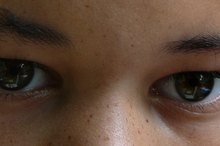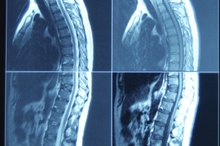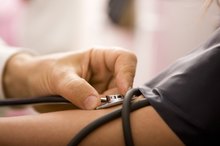Problems With Inversion Boots
Inversion boots, or gravity boots, are fitness gadgets that wrap around your ankles, allowing you to hang upside down from a bar. They are used in inversion therapy to apply traction to your back with the goal of decompressing the vertebrae of your spine. While inversion boots were popular in the 1980s, proponents of inversion therapy have largely replaced boots with inversion tables, devices that tilt your body at an angle without requiring you to hang completely upside down. However, inversion therapy not only offers no long-term relief from back pain, but also presents dangers to your health under certain conditions, cautions Dr. Randy Shelerud of the Mayo Clinic.
Blood Pressure Problems
Hanging upside down with the use of inversion boots for more than two or three minutes raises your blood pressure to possibly dangerous levels. A 1983 study by Dr. Ronald Klatz in the “British Journal of Sports Medicine” determined that inversion therapy increased both systolic and diastolic blood pressure significantly more than what would be expected during strenuous exercise. His subjects were young and healthy, and they remained inverted for three minutes prior to blood pressure measurement. Because typical inversion therapy may continue for 20 minutes at a time by older and less healthy individuals, blood pressure elevation may prove hazardous to these populations. For this reason, Klatz recommends that people with hypertension, a family history of stroke and those over the age of 55 or taking anticoagulants avoid inversion therapy.
- Hanging upside down with the use of inversion boots for more than two or three minutes raises your blood pressure to possibly dangerous levels.
- Because typical inversion therapy may continue for 20 minutes at a time by older and less healthy individuals, blood pressure elevation may prove hazardous to these populations.
Eye Problems
What Causes Light Flashes in the Eye?
Learn More
In addition to raising blood pressure, inversion therapy increases intraocular pressure, or pressure within your eye. In the March 1985 volume of the “Journal of the American Medical Association,” Dr. T. Friberg reports that inversion therapy more than doubled intraocular pressure compared with study subjects who remain seated in an upright position. Under conditions of inversion therapy, eye pressure increased to levels associated with glaucoma, and study subjects also experienced eye tearing, eye congestion and bleeding in the subconjunctival region. Friberg suggests that people with glaucoma, macular degeneration, ocular hypertension or any other disorder of the eye vasculature refrain from inversion therapy, whether using inversion boots or an inversion table.
- In addition to raising blood pressure, inversion therapy increases intraocular pressure, or pressure within your eye.
- Under conditions of inversion therapy, eye pressure increased to levels associated with glaucoma, and study subjects also experienced eye tearing, eye congestion and bleeding in the subconjunctival region.
Other Problems
A variety of other health concerns are contraindicated for the use of inversion therapy, states senior medical editor Susan Spinasanta of SpineUniverse. Any condition that is sensitive to pressure, such as bone fracture, osteoporosis, retinal detachment, hernia, eye infection or ear infection, may be worsened by the use of inversion boots or an inversion table. Additionally, inversion therapy slows your heartbeat as it raises blood pressure and may result in further health issues for people with cardiovascular problems. Finally, Spinasanta advises the pregnant and obese to abstain from inversion therapy.
- A variety of other health concerns are contraindicated for the use of inversion therapy, states senior medical editor Susan Spinasanta of SpineUniverse.
- Finally, Spinasanta advises the pregnant and obese to abstain from inversion therapy.
Related Articles
References
- "The Western Journal of Medicine"; Gravity Inversion Therapy; Ronald M. Klatz; October 1983
- MayoClinic.com: Does Inversion Therapy Relieve Back Pain? Is It safe?
- “British Journal of Sports Medicine”; Gravity Inversion Boots--A Potential Hazard; R.M. Klatz; 1983
- PubMed: Ocular Manifestations of Gravity Inversion
- SpineUniverse: Turning Back Pain and Sciatica Upside Down
- Chronic Back Pain. Health Policy Institute. https://hpi.georgetown.edu/backpain/. Published February 13, 2019.
- Wegner I, Widyahening IS, Van tulder MW, et al. Traction for low-back pain with or without sciatica. Cochrane Database Syst Rev. 2013;(8):CD003010. doi:10.1002/14651858.CD003010.pub5
- McMonnies CW. Intraocular pressure and glaucoma: Is physical exercise beneficial or a risk?. J Optom. 2016;9(3):139–147. doi:10.1016/j.optom.2015.12.001
- Chronic Back Pain. Health Policy Institute. Published February 13, 2019.
- Kong L, Tian W, Cao P, Wang H, Zhang B, Shen Y. Predictive factors associated with neck pain in patients with cervical disc degeneration: A cross-sectional study focusing on Modic changes. Medicine (Baltimore). 2017;96(43):e8447. doi:10.1097/MD.0000000000008447
Writer Bio
A writer since 1985, Jan Annigan is published in "Plant Physiology," "Proceedings of the National Academy of Sciences," "Journal of Biological Chemistry" and on various websites. She holds a sports medicine and human performance certificate from the University of Washington, as well as a Bachelor of Science in animal sciences from Purdue University.








